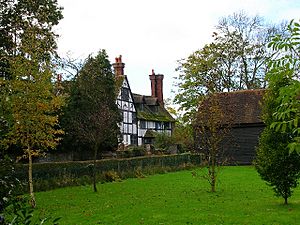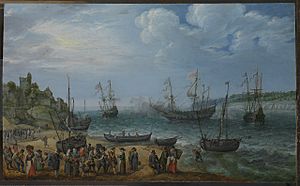Edward Michelborne facts for kids
Sir Edward Michelborne (born around 1562, died 1609) was an English soldier, adventurer, and explorer. He was also known as Michelbourn. After serving in the military in the 1590s, he wanted to lead the first journey for the East India Company (EIC). However, he was not chosen for this important role.
Later, with King James I's permission, he became an "interloper." This meant he traded in places where the East India Company had special rights. In December 1604, he sailed to the Far East. During his trip, he took goods without permission and also tried to trade. His actions upset the East India Company. When he returned to England in 1606, they complained about him to the King's advisors, known as the Privy Council.
Contents
Early Life and Military Career
Edward Michelborne was the oldest son of Edward Michelborne, a landowner from Clayton, West Sussex. His mother was Jane Parsons from Steyning, Sussex. In 1565, his family moved into a new house called Hammonds Place Farmhouse in Burgess Hill.
Edward became a captain in the Low Countries (modern-day Netherlands and Belgium) in 1591. He stayed in the Queen's service until 1598. In that year, he led a group of soldiers in Ostend. He also commanded a ship called the Moon during a naval journey to the Islands in 1597.
In 1593, he became a Member of Parliament for Bramber. He was usually known as being from 'Hamondes, Sussex'. In 1599, he served in Ireland and was knighted by the Earl of Essex in Dublin.
Challenges with the East India Company
On October 16, 1599, Lord Buckhurst, a high-ranking government official, suggested Michelborne to the new East India Company (EIC). He wanted Michelborne to be the main leader for their first voyage. However, the company did not want to hire any gentlemen for important positions. They preferred to choose their own people.
A year later, Lord Buckhurst tried again to persuade the company. But they still decided not to hire Michelborne. They asked the Lord Treasurer to let them manage their business with people they knew. Michelborne was allowed to invest in the company, and his name was fourth on the list of people who received the company's official charter. Meanwhile, James Lancaster was chosen to lead the first voyage.
In February 1601, Michelborne was involved in a rebellion led by the Earl of Essex. He might have helped hold the Lord Keeper and Lord Chief Justice on February 8. He was questioned about this but only had to pay a fine of £200. He claimed he had gone to Essex's house to hear a sermon and left when he heard Queen Elizabeth's order to arrest Essex.
The East India Company saw this as a chance to get rid of him. He had also failed to pay his investment for the first voyage. So, on July 6, 1601, the EIC decided to remove him from the company. This meant he lost all his rights and benefits as a member.
Journey to the Far East
By 1603, King James I wanted to get involved in the valuable spice trade. He was worried because the East India Company had only made two voyages instead of the expected six. So, in 1604, the King gave Michelborne a special license. This license allowed him to explore and trade in places like Cathay (China), Japan, Korea, and Cambay. This was allowed even though the East India Company had a special trading agreement.
Michelborne became the first "interloper." This meant he traded unlawfully, breaking the East India Company's special rights. On December 5, 1604, Michelborne sailed on a ship called the Tiger. He had another ship, the Tiger's Whelp, and a famous pilot named John Davis with him.
Even though the trip was supposed to be for discovery and trade, Michelborne often took goods without permission. He robbed local traders in the Indian Archipelago, which caused big problems for the East India Company.
Between October 28 and November 2, 1605, in Bantam, he stopped the Dutch East India Company from expanding too much. However, he also took goods from a rich Chinese ship heading to Java. The Dutch later took revenge for his attacks, which led to a terrible event in 1623 called the Amboyna massacre.
Michelborne made a serious mistake by letting Japanese pirates onto the Tiger. The pirates attacked the crew, and John Davis died. The crew fought back by firing cannons through a cabin wall, which defeated the pirates. Only one pirate survived, and Michelborne ordered him to be hanged. But the rope broke, and the pirate fell into the sea.
After Davis's death and complaints from merchants, Michelborne decided to return to England. He arrived on July 9, 1606. The angry East India Company complained to the Privy Council. They realized they needed to make their position stronger in the Spice Islands. William Keeling was then sent on the company's third voyage.
Three years after Michelborne left Bantam, an agent for the company wrote about the bad effects of his journey. He said that the English traders there would be in great danger if anyone else like Michelborne was allowed to act as he did.
Later Life
After returning home, Michelborne settled in Hackney, near London. He owned a house and land there. He died in 1609 and was buried on May 4 at the Church of St John-at-Hackney.
In his will, dated March 22, 1609, he left a total of £55 to the poor people of Clayton, Penshurst, and Lickfold, Lodsworth, all in Sussex. His will also mentioned that Lord Buckhurst owed him £400. Michelborne was survived by his son, Edward (born 1587), who studied at Christ Church, Oxford, and later at the Middle Temple.
Images for kids





